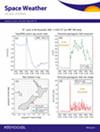Prediction of Global Ionospheric Total Electron Content (TEC) Based on SAM-ConvLSTM Model
IF 3.7
2区 地球科学
引用次数: 0
Abstract
This paper first applies a prediction model based on self-attention memory ConvLSTM (SAM-ConvLSTM) to predict the global ionospheric total electron content (TEC) maps with up to 1 day of lead time. We choose the global ionospheric TEC maps released by the Center for Orbit Determination in Europe (CODE) as the training data set covering the period from 1999 to 2022. Besides that, we put several space environment data as additional multivariate-features into the framework of the prediction model to enhance its forecasting ability. In order to confirm the efficiency of the proposed model, the other two prediction models based on convolutional long short-term memory (LSTM) are used for comparison. The three models are trained and evaluated on the same data set. Results show that the proposed SAM-ConvLSTM prediction model performs more accurately than the other two models, and more stably under space weather events. In order to assess the generalization capabilities of the proposed model amidst severe space weather occurrences, we selected the period of 22–25 April 2023, characterized by a potent geomagnetic storm, for experimental validation. Subsequently, we employed the 1-day predicted global TEC products from the Center for Operational Products and Services (COPG) and the SAM-ConvLSTM model to evaluate their respective forecasting prowess. The results show that the SAM-ConvLSTM prediction model achieves lower prediction error. In one word, the ionospheric TEC prediction model proposed in this paper can establish the ionosphere TEC of spatio-temporal data association for a long time, and realize high precision of prediction performance.基于 SAM-ConvLSTM 模型的全球电离层总电子含量 (TEC) 预测
本文首先应用基于自注意记忆 ConvLSTM(SAM-ConvLSTM)的预测模型来预测全球电离层电子总含量(TEC)地图,预测时间最长可达 1 天。我们选择欧洲轨道测定中心(CODE)发布的全球电离层总电子含量图作为训练数据集,时间跨度为 1999 年至 2022 年。此外,我们还将一些空间环境数据作为附加的多元特征纳入预测模型框架,以增强其预测能力。为了证实所提模型的效率,我们还使用了另外两个基于卷积长短期记忆(LSTM)的预测模型进行比较。这三个模型在相同的数据集上进行了训练和评估。结果表明,所提出的 SAM-ConvLSTM 预测模型比其他两个模型更准确,在空间天气事件中的表现也更稳定。为了评估所提出的模型在恶劣空间天气事件中的泛化能力,我们选择了 2023 年 4 月 22 日至 25 日这一强烈地磁暴时期进行实验验证。随后,我们利用运行产品和服务中心(COGG)的 1 天全球 TEC 预测产品和 SAM-ConvLSTM 模型来评估它们各自的预报能力。结果表明,SAM-ConvLSTM 预测模型的预测误差较小。总之,本文提出的电离层 TEC 预报模型可以建立电离层 TEC 的长时间时空数据关联,实现高精度的预报性能。
本文章由计算机程序翻译,如有差异,请以英文原文为准。
求助全文
约1分钟内获得全文
求助全文

 求助内容:
求助内容: 应助结果提醒方式:
应助结果提醒方式:


